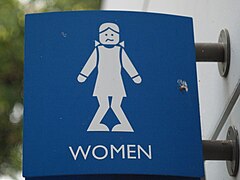🚺
Jump to navigation
Jump to search
 | ||||||||
| ||||||||
Translingual[edit]

Symbol origin[edit]
The female restroom pictogram, alongside the male equivalent, 🚹︎, and unisex 🚻, were each created in circa 1965 by British Rail for their train stations.[1][2] The symbol became standardised in the United States in 1974 when the Department of Transportation collaborated with the American Institute of Graphic Arts et al. on iconography for the public called the DOT pictograms, which included several versions of 🚺.[3] The depictions were based on the Isotype picture language developed in Austria between 1925 and 1934.[4][5]
The other senses take 🚺 literally.
Description[edit]
Depiction of a woman standing.
Symbol[edit]
🚺︎
- Marks a public toilet used by women.
- 1976, Rudolf Modley, William R. Myers, Handbook of Pictorial Symbols: 3,250 examples from international sources (in English), Dover Publications, →ISBN, page 60:
- Toilets, Women 🚺
- Marks text or content aimed at women.
- (uncommon, less common than ♀) Marks an area or place intended only for women.
Usage notes[edit]
- Depictions of the symbol vary, but it is generally shown to be a stick figure wearing a skirt.[6] At restaurants and other businesses, it is common to see novelty and jocular variations of the icon, especially in regards to 🚹︎ (see the usage notes of 🚻).[7]
- The symbol (named "Toilets - female" and designated PF 005) is part of the ISO 7001 set of pictograms and symbols for "public information" by the International Organization for Standardization.[8]
- As an emoji, all operating systems display this symbol as either a purple, red or blue box with a stick figure wearing a skirt. iOS, Facebook and WhatsApp for Android and desktop, Telegram—which uses animated versions of Apple's emoji—and the erstwhile LG emoji set among others use a stylised depiction of the woman with a single leg. The box is purple or pink on iOS, Facebook, Samsung, Microsoft's erstwhile emoji set, WhatsApp, Telegram, Twemoji (used by Twitter and Discord) and JoyPixels among others; and blue on Google's Noto Color Emoji project, Skype and OpenMoji.[9] The Unicode character itself was released in Unicode 6.0 in October 2010.[10]
Gallery[edit]
- Depictions
-
ISO 7001
-
DOT pictogram
-
A common emoji depiction (in pink; Twemoji pictured)
-
Example of a humorous design in California
Synonyms[edit]
Antonyms[edit]
Hypernyms[edit]
- 🚻︎ (“marks public toilets”)
See also[edit]
- 🚼 (“marks a baby changing station”)
 Gender symbol on Wikipedia.Wikipedia
Gender symbol on Wikipedia.Wikipedia
References[edit]
- ^ Association of Public Lighting Engineers (1965) The Illuminating Engineer[1], volume 58, Illuminating Engineering Publishing Company, page 347: “A total lighting load of 20 kw for a toilet may sound excessive but the new luxury toilets recently opened at Victoria Station by British Rail are an exception. […] Large illuminated signs over the entrances incorporate easily recognised continental style pictograms.”
- ^ Jonathan Glancey (2014 September 11) “The genius behind stick figure toilet signs”, in BBC Future[2], BBC News
- ^ American Institute of Graphic Arts (1974 November) Symbol Signs: The Development of Passenger/Pedestrian Oriented Symbols for Use in Transportation-Related Facilities[3], United States Department of Transportation, pages 28–32
- ^ Steven Heller (2014 April 24) “The Utopian Origins of Restroom Symbols”, in The Atlantic[4]
- ^ Margaret Rhodes (2015 May 22) “Redesigned ladies restroom icon cleverly skirts skirt”, in Wired[5]
- ^ Søren Kjørup (2004) “Pictograms”, in Klaus Robering, Roland Posner, Thomas Albert Sebeok, editor, Semiotik / Semiotics (Handbooks of Linguistics and Communication Science), volume 4, De Gruyter, →ISBN, page 3505: “Read as a picture, it typically shows, in a more or less detailed way, a person dressed in long pants, as opposed to the "picture" on the door to the ladies' room which shows a person wearing a skirt.”
- ^ Melanie Gervasoni (2023 September 10) “50 Funny Bathroom Signs People Found Around The World”, in Bored Panda[6]
- ^ International Organization for Standardization (ISO) (2023 February) “Public information symbols”, in ISO 7001:2023: Graphical symbols — Registered public information symbols, 4 edition, ISO
- ^ “🚺 Women's Room”, in Emojipedia[7], 2023 October 6 (last accessed), Emoji Designs
- ^ “Version 6.0.0”, in The Unicode Standard[8], Unicode Consortium, 2010 October 11, retrieved 5 October 2023
| Text style |
Emoji style |
|---|---|
| 🚺︎ | 🚺️ |
| Note: Character's appearance may be different on each system. Text style is forced with ︎ and emoji style with ️ | |



